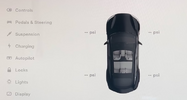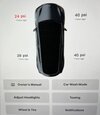As winter approaches, thoughts often turn to the challenges of cold-weather driving, particularly for Tesla owners. One common issue is the loss of tire pressure, a problem exacerbated by colder temperatures. While not as dramatic as a flat tire, driving with reduced tire pressure can lead to safety hazards and decreased performance.
Before we delve into the solutions, let's explore the science behind why tire pressure drops in cold weather and how a portable air compressor can be your best ally on winter roads.

We know that at warmer temperatures, molecules move faster and occupy a lot more space. However, in cold weather, the reverse happens. Air molecules move very slowly, making air denser. This is why the same amount of air might not occupy all the space inside your car tire in winter as it does in summer.
As an outcome of this increased air density, car tires flatten more often in winter, ie. tire pressure reduces more frequently.
So, you can understand that while reduced driving range has more of a financial impact, the other two outcomes can become safety hazards on the road.
Also, EVs exhibit higher torque compared to their gas-powered counterparts, because of their swift acceleration. This has a huge impact on the tires, as EVs apply more force during rapid acceleration.

Source: Machine Design
Additionally, EVs utilize regenerative braking, reversing torque much more frequently than ICE vehicles. Consequently, this accelerated braking contributes to quicker tire wear.
Therefore, keeping an eye on your EV’s tire pressure is crucial.

Tesla models 3, Y, and X are all recommended having a 42 psi tire pressure, while Model S has a recommended range of 38-45 psi.
This is because Model S offers the option of square and staggered tires. In the case of square tires, all tires are of the same width. So, if you have 245/35R21/XL 96W tires in your Model S, you must maintain a 42 psi pressure. However, with 245/45R19 98W tires, you must maintain a pressure of 45 psi.
In the case of staggered tires, the back tires are wider than the front ones. Therefore, the front tires should have lower tire pressure than the back ones. Specifically, 245/35R21/XL 96Y tires in the front should have 38-45 psi tire pressure, and the 265/35R21/XL 101Y tires in the back should have 40-45 psi.
Apart from tire pressure, you should also keep track of the tread depth. Especially, in the case of a Tesla, the tires should have an ideal tread depth of at least 3 mm in wet conditions and at least 4 mm in snow and slush.
You can access Car Status using the right or left steering wheel buttons and check the pressure of each tire. You can toggle between Bar or PSI from Controls > Display > Tire Pressure menu. Also, the mobile app displays tire pressure.
However, the tire pressure doesn’t get updated immediately after reinflation. You might have to drive a short distance before the tire pressure is updated on the screen.

If you are on a road trip, or going camping, you might not always have access to a gas station. In such a case, a portable air compressor would come in very handy. This is why, we have developed a Tesla-compatible one.
Some of its top features include:
1. Fast Inflation & Optimum Performance: Jowua portable air compressor reduces the inflation time by half. Additionally, on one charge, we were able to do 13 inflations. The tire pressure was increased from 36 to 42 psi in minimum 76 and maximum 106 seconds, i.e. under 2 minutes.

2. Powerful Alloy Casting Cylinder: As the air compressor is designed especially for EVs, you need not worry about not meeting the EV’s high tire pressure requirements.
3. Large Screen & Compact Form Factor: Teslas don’t display the current tire pressure right after inflation; it does that after you have driven at least 25 km after reinflating. This is why, knowing the exact pressure after pumping is important.

Traditional compressors are not handy enough, so it is difficult to get the exact pressure reading while the air gets pumped. This may lead to over-inflation. However, as our air compressor is portable with a large display, you can easily hold it while it pumps and also see the exact reading during the process.

4. 60W High-speed Charging: Keeping portability in mind, we have designed the portable air compressor to support 60W fast charging. This means you can get it fully charged in just 30 minutes.

Overall, you need not worry about low tire pressure this winter, no matter where you are driving in your Tesla. Just grab our portable air compressor, put it in your sub-trunk, and get on the road.
We’ve included a coupon code for TMC readers — so just use TMC5 when you make a purchase. Here is a direct link to the product: Portable Air Compressor for Tesla & Tire Valve Caps Combo.
Before we delve into the solutions, let's explore the science behind why tire pressure drops in cold weather and how a portable air compressor can be your best ally on winter roads.
Why do car tires deflate more in winter?
We know that at warmer temperatures, molecules move faster and occupy a lot more space. However, in cold weather, the reverse happens. Air molecules move very slowly, making air denser. This is why the same amount of air might not occupy all the space inside your car tire in winter as it does in summer.
As an outcome of this increased air density, car tires flatten more often in winter, ie. tire pressure reduces more frequently.
How unsafe is low tire pressure?
Not only the tires, the vehicle, and you yourself are at great risk if you ignore the low tire pressure light on your dashboard. Reduced tire pressure can impact:- Driving Range: Especially in the case of EVs, low tire pressure results in reduced driving range. Flatter tires cause greater rolling resistance, putting more pressure on the motor to propel the vehicle forward. This causes higher energy consumption and a shorter driving range. It’s a huge battery drain.
- Vehicle Handling: Tire pressure impacts the starting, stopping, and steering of your car. Low tire pressure can lead to reduced responsiveness of your vehicle handling. Your vehicle might skid and cause you injury.
- Tread-Wear: Due to low tire pressure, your tires are more exposed to tread-wear. This may lead to more rapid or irregular wear or even a sudden tire failure, causing serious injury.
So, you can understand that while reduced driving range has more of a financial impact, the other two outcomes can become safety hazards on the road.
Why is tire pressure more crucial for EVs?
Maintaining the right tire pressure is much more important for EVs than for ICE vehicles. EVs are heavier and exert approximately 20% more weight on the tires. But the tires don’t bear the weight of the vehicle, it’s actually the air inside the tires that bears all the load. This is why maintaining the right tire pressure is of utmost importance, and even more important for EVs.Also, EVs exhibit higher torque compared to their gas-powered counterparts, because of their swift acceleration. This has a huge impact on the tires, as EVs apply more force during rapid acceleration.
Source: Machine Design
Additionally, EVs utilize regenerative braking, reversing torque much more frequently than ICE vehicles. Consequently, this accelerated braking contributes to quicker tire wear.
Therefore, keeping an eye on your EV’s tire pressure is crucial.
What is the ideal tire pressure for your Tesla?
You must maintain the tire pressure mentioned on the Tire Information Label instead of what’s printed on the tire itself. You can find this label stuck on the center door pillar when you open the driver door.Tesla models 3, Y, and X are all recommended having a 42 psi tire pressure, while Model S has a recommended range of 38-45 psi.
This is because Model S offers the option of square and staggered tires. In the case of square tires, all tires are of the same width. So, if you have 245/35R21/XL 96W tires in your Model S, you must maintain a 42 psi pressure. However, with 245/45R19 98W tires, you must maintain a pressure of 45 psi.
In the case of staggered tires, the back tires are wider than the front ones. Therefore, the front tires should have lower tire pressure than the back ones. Specifically, 245/35R21/XL 96Y tires in the front should have 38-45 psi tire pressure, and the 265/35R21/XL 101Y tires in the back should have 40-45 psi.
Apart from tire pressure, you should also keep track of the tread depth. Especially, in the case of a Tesla, the tires should have an ideal tread depth of at least 3 mm in wet conditions and at least 4 mm in snow and slush.
How to check the tire pressure of your Tesla?
Tesla’s Tire and Car Maintenance manual points out that the instrument panel displays tire pressure.You can access Car Status using the right or left steering wheel buttons and check the pressure of each tire. You can toggle between Bar or PSI from Controls > Display > Tire Pressure menu. Also, the mobile app displays tire pressure.
However, the tire pressure doesn’t get updated immediately after reinflation. You might have to drive a short distance before the tire pressure is updated on the screen.
How to maintain the tire pressure of your Tesla?
While heading to the gas station is a great option for getting your Tesla’s tire pressure checked, it might not always be the best option.If you are on a road trip, or going camping, you might not always have access to a gas station. In such a case, a portable air compressor would come in very handy. This is why, we have developed a Tesla-compatible one.
Some of its top features include:
1. Fast Inflation & Optimum Performance: Jowua portable air compressor reduces the inflation time by half. Additionally, on one charge, we were able to do 13 inflations. The tire pressure was increased from 36 to 42 psi in minimum 76 and maximum 106 seconds, i.e. under 2 minutes.
2. Powerful Alloy Casting Cylinder: As the air compressor is designed especially for EVs, you need not worry about not meeting the EV’s high tire pressure requirements.
3. Large Screen & Compact Form Factor: Teslas don’t display the current tire pressure right after inflation; it does that after you have driven at least 25 km after reinflating. This is why, knowing the exact pressure after pumping is important.
Traditional compressors are not handy enough, so it is difficult to get the exact pressure reading while the air gets pumped. This may lead to over-inflation. However, as our air compressor is portable with a large display, you can easily hold it while it pumps and also see the exact reading during the process.
4. 60W High-speed Charging: Keeping portability in mind, we have designed the portable air compressor to support 60W fast charging. This means you can get it fully charged in just 30 minutes.
Overall, you need not worry about low tire pressure this winter, no matter where you are driving in your Tesla. Just grab our portable air compressor, put it in your sub-trunk, and get on the road.
We’ve included a coupon code for TMC readers — so just use TMC5 when you make a purchase. Here is a direct link to the product: Portable Air Compressor for Tesla & Tire Valve Caps Combo.
Attachments
Last edited:





